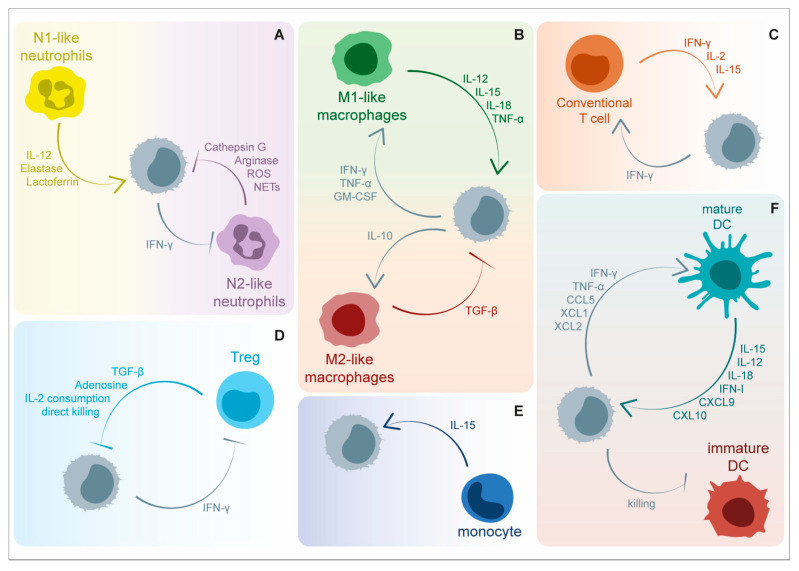Figure 2.
Soluble factors involved in the bi-directional crosstalk between NK cells and immune cells within tumor microenvironment (TME). NK-cell-mediated anti-tumor functions are positively and negatively modulated by a great variety of cytokines and other soluble factors released by immune cells. (A) Neutrophils are able to negatively modulate the expression of NKp46 through the release of Cathepsin G and reactive oxygen species (ROS). Additionally, arginine depletion and neutrophil extracellular trap (NET) release are involved in the blockade of NK-cell effector functions, including IFN-γ release and target cell killing. On the contrary, neutrophil-derived elastase, lactoferrin, and interleukin (IL)-12 enhance NK-cell functionality. NK-cell-released IFN-γ suppresses angiogenic activity of tumor-associated neutrophils. (B) M1-activated tumor associated macrophages are involved in NK cell triggering via IL-12, IL-15, IL-18, and tumor necrosis factor (TNF)-α, while M2-polarized macrophages counteract the above-mentioned activation mechanisms through transforming growth factor (TGF)-β release. On the other side, NK cells can foster macrophage functions through the secretion of IFN-γ, TNF-α, granulocyte-macrophage colony-stimulating factor (GM-CSF), and IL-10. (C) NK-cell-derived IFN-γ promotes anti-tumor T helper cell type 1 (Th1) polarization in CD4+ T cells and the cytolytic functions of CD8+ T cells. Concomitantly, T cells release IL-2 and IL-15, cytokines that are critically involved in NK cell survival and activation. (D) NK-cell-mediated tumor killing and IFN-γ release are negatively affected by immunosuppressive molecules, including TGF-β and adenosine, produced by regulatory T cells (Treg). The competition for IL-2 consumption represents an additional strategy exploited by regulatory T cells to suppress NK cell functions together with granzyme B-mediated direct killing. (E) Patrolling monocytes sustain NK cell anti-metastatic functions by IL-15 release. (F) The interaction between NK cells and Dendritic Cells (DCs) results in reciprocal activation. Mature DCs release cytokines able to promote NK cell activation and recruitment, including IL-12, IL-15, IL-18, C-X-C Motif Chemokine Ligand 9 (CXCL9), and CXCL10. Direct killing of immature DCs further foster optimal activation of the DC-mediated immune response. On the other side, the activation and recruitment of DCs at the tumor bed is favored by IFN-γ, TNF-α, CCL5, X-C Motif Chemokine Ligand 1 (XCL1), and XCL2. Created partly with BioRender.com.

